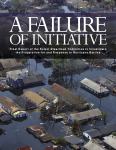 National Preparedness Month (NPM) takes place each September and is an ongoing reminder to review the necessary preparations you should take in the event of a natural disaster. This September the sentiment seems even more relevant than most years as the Eastern coast feels the impact of Hurricane Florence and the Western States recover from a particularly deadly fire season.
National Preparedness Month (NPM) takes place each September and is an ongoing reminder to review the necessary preparations you should take in the event of a natural disaster. This September the sentiment seems even more relevant than most years as the Eastern coast feels the impact of Hurricane Florence and the Western States recover from a particularly deadly fire season.
This NPM the focus is on planning, with an overarching theme of: Disasters Happen. Prepare Now. Learn How., according to ready.gov. Visit the website today to get free reference materials, checklists, and information on how to best prepare for a natural disaster. It’s important to remember that nothing can beat being prepared when a disaster occurs, and there is no substitute for thinking ahead.
Some simple tips to help you prepare now:
- Know how to perform some basic home maintenance like securing TVs, dressers, and appliances in event of an earthquake.
- Learn how to turn off the utilities to your house like natural gas and water in the event of leaks or broken pipes.
- Ensure your smoke alarms are working with fresh batteries, and also keep a fire extinguisher with the right ratings available in your home.
- Learn CPR, and keep a First Aid Kit ready in your home.
- Work with all your family to ensure that everyone knows how to evacuate the house beforehand.
Some other important information available on epa.gov, is how to report emergencies and some general information about any emergency.
The U.S. Government Publishing Office (GPO) also offers several items that can help you prepare this NPM. On govinfo, there is a newly-published feature article that offers several links to related publications on disaster preparedness. These publications cover a variety of topics ranging from the National Flood Insurance Program Administrative Reform Act of 2017 to the Pets Evacuation to the Disaster Relief Act of 1974.
 GPO also offers access to several items that can help your organization celebrate this unique history. The U.S. Government Bookstore offers several titles about this topic in the Disaster Preparedness Collection.
GPO also offers access to several items that can help your organization celebrate this unique history. The U.S. Government Bookstore offers several titles about this topic in the Disaster Preparedness Collection.
Some of those include:
- National Response Framework, 2008 – National Response Framework is a guide to how the Nation conducts all-hazards response. It is built upon scalable, flexible, and adaptable coordinating structures to align key roles and responsibilities across the Nation, linking all levels of government, nongovernmental organizations, and the private sector. It is intended to capture specific authorities and best practices for managing incidents that range from the serious but purely local, to large-scale terrorist attacks or catastrophic natural disasters.
- Disaster Preparedness Manual: Natural Disasters, Man-Made Disasters, Patient Fact Sheets – The U.S. Department of Veterans Affairs takes disaster planning and response very seriously. This manual, comprised of three major sections, summarizes actions that Veterans and their families can take to effectively cope with a disaster. The sections are:
- Natural Disasters (tornadoes, floods, etc.)
- Man-Made Disasters (chemical attacks, bombings, etc.)
- Patient Fact Sheets
- Owlie Skywarn’s Weather Book – Provides an easy to read pamphlet about storms: hurricanes, tornadoes, blizzards, lightning, emergency preparation kits, safety at school, and more. Although written to be understandable for children ages 8 to 12, it contains valuable disaster preparation and response information of use to parents, teachers and other adults. At head of title on cover: Watch Out Storms Ahead.
GPO’s commitment to Keeping America Informed will continue to strive to provide access to Government information on all issues that affect the public in all aspects of their life.
The GPO Online Bookstore – Easy Access to Federal Publications
HOW DO I OBTAIN THESE RESOURCES?
Shop Online Anytime: You can buy eBooks or print publications —with FREE Standard Shipping worldwide— from the U.S. Government Online Bookstore at https://bookstore.gpo.gov.
- Click here to purchase National Response Framework, 2008
- Click here to purchase Disaster Preparedness Manual: Natural Disasters, Man-Made Disasters, Patient Fact Sheets
- Click here to purchase Owlie Skywarn’s Weather Book
- Click here to purchase Federal Emergency Management Agency Incident Management Handbook
- Click here to browse our Disaster Preparedness collection
Shop our Retail Store: Buy a copy of any print editions from this collection at GPO’s retail bookstore at 710 North Capitol Street NW, Washington, DC 20401, open Monday–Friday, 9 a.m. to 4 p.m., except Federal holidays, Call (202) 512-0132 for information or to arrange in-store pick-up.
Order by Phone: Call our Customer Contact Center Monday through Friday, 8 am to 5:30 pm Eastern (except US Federal holidays). From US and Canada, call toll-free 1.866.512.1800. DC or International customers call +1.202.512.1800.
Visit a Federal depository library: Search for U.S. Government publications in a nearby Federal depository library. You can find the records for most titles in GPO’s Catalog of U.S. Government Publications.
Find more than a million official Federal Government publications from all three branches at www.govinfo.gov.
About the author: Blogger contributor Scott Pauley is a Writer and Editor in GPO’s Library Services and Content Management offices.



 Posted by Trudy Hawkins
Posted by Trudy Hawkins 














 Floods: The Awesome Power
Floods: The Awesome Power



